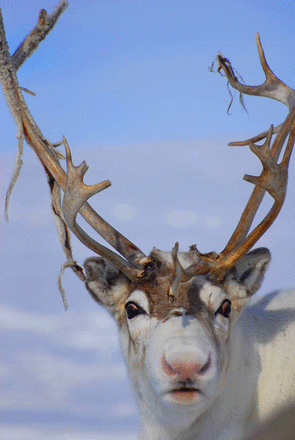Reindeer actually have red noses, says S.Ananthanarayanan.
It is just past Christmas and Santa Claus may have got back to the North Pole, riding his sleigh drawn by reindeer. Legend has it that the leader of the pack is Rudolf, the reindeer who was 'kept out of reindeer games' by other reindeer because of his red nose. This was till Santa said, one Christmas eve, "Rudolph, with your nose so bright, won't you guide my sleigh tonight?" Scientists in The Netherlands and Norway have found that reindeer do have noses that are red, and for good reason.

Anne-Marije van Kuijen, Wytske J Fokkens, Arnoldus S Blix, Dan M J Milstein, Koray Yürük and Lars P Folkow, from Medical Centres in the Erasmus University, Rotterdam, and the University of Amsterdam, and the Department of Arctic and Marine Biology, University of Tromsø, Norway, harnessed the technology of 'hand held video microscopy' to delve into the blood flow in the tissues of the nose. Apart from human noses, they also studied reindeer, and in a paper in one Christmas issue of BMJ, the journal of the British Medical Association, they find that Rudolf's red nose is because of 'highly dense and rich nasal microcirculation.'
Microcirculation
Circulation of blood takes place through macro-circulation, or blood flow to and from organs. And within organs the flow is through finer blood vessels, the capillaries, which can be as narrow as 10 microns in diameter. It is at this 'delivery end' of circulation that the finest blood vessels communicate with cell tissue to regulate blood pressure, fluid levels, exchange of nutrients and gases and temperature. These finest blood vessels have specific structure to help these functions, to permit smooth blood flow, transfer of water and dissolved material through the vessel wall and arrangements to constrict the vessels, to regulate blood pressure.
A part of the body that is well provided with such blood vessels, for special functions, is the lining of the nose, "The nasal microcirculation has important physiological roles such as heating, filtering, and humidifying inhaled air, controlling inflammation, transporting fluid for mucous formation, and delivering oxygen to the main, functional nasal cells and also in the uptake of drugs and responses to allergens," says the paper.
The way the nasal blood-tissue interface senses and regulates much of the body's adaptation to the environment is through continuous contact and interaction with inhaled air. In many animals, the nose is an organ that is highly adapted. A well-known example is the cold nose of the dog, its unparalleled organ of scent. Another is the nose-like region in the head of the snake, which has evolved to be heat-sensing, and helps snakes locate prey. In the case of humans, however, enquiry was hampered by difficulty of access, while people are conscious and their noses are in action. This, fortunately, has changed, with the development of devices that allow in vivo microscopy and even video imaging within organs. The devices have proved to be powerful diagnostic tools and it is found that a most sensitive indicator of outcome and response to treatment is the microcirculation in the nose.
The researchers used adult volunteers to assess the nature and responses. The circulation was imaged using probes that allowed a lens to be inserted into the nasal cavity and the data was analysed using specialized software, and statistical methods. The imaging revealed dense capillary formations in loops or circles, with hairpin-like branching, to the exclusion of larger vessels. The analysis allowed assessment of how the blood flow changes when different drugs are administered or when there are changes in the layout of capillaries in a volunteer with diseased nasal tissue.
While the focus has thus moved to the study of the nose, in the case of humans, among animals, the nose has lent itself to a variety of ways of adaptation, by different species. A specific instance is that of the Arabian Ibex, an animal that is able to survive in desert condition of heightened temperature and very low humidity. The Ibex economises on the use of water for cooling by allowing its body temperature to rise but still ensures temperature regulation of blood supply to the brain, with the help of a moisture-saving, evaporative cooling mechanism located in the nasal passage. While this is adaptation for arid and high temperature, the Netherlands/Norway study has found a parallel adaptation of the reindeer nose, but to suit the sub-zero conditions of the Tundra.
Reindeer
The mammalian, or reptile, nose needs to be kept moist and irrigated, apart from temperature regulated, so that it can respond to gases and other factors in the environment. The moist nose of the dog is great example of the organ being both sensitive and cool, for the best response. In the case of the reindeer, which inhabits ice-bound areas, cooling for better response may not be relevant. Conversely, at subzero temperatures, low temperature brings down the olfactory response. And, there is the possibility of the moist reindeer nose getting covered with frost! The need of the hour is thus warming – and this can come about by the flow of warm blood.
The study in the BMJ paper carried out hand held video microscopy study of the nasal cavity of reindeer, in Norway. The results were that reindeer nose mucous tissue is a good 25% richer in capillary structures than the human nose. Infra-red-light studies of reindeer showed that the nose of the reindeer is indeed red, and this is a result of concentration of blood supply to the nose, as an adaptation to extreme cold. The study also revealed gland like structures in the mucous lining of the reindeer nose, which may be for maintaining humidity and fluids.
The study reported is of some years ago, and there may be better data available by now. But the study brings Christmas cheer, for it tells us that Rudolf’s red nose is for real!
Alcohol does it too
An effect of alcohol in the bloodstream is that the peripheral capillaries, or the outermost, fine blood vessels of the body, get dilated, or widen. There is thus increased blood flow and rise in the body surface temperature. This is the reason that a shot of brandy gives a feeling of warmth, particularly if one is well covered or indoors. Conversely, the body adapts by constricting peripheral capillaries when it is cold. Swigging brandy when out in the cold could thus result in more loss of body heat. Or worse, a well covered person could feel warm and unbutton a coat, resulting in exposure.

Readers of Asterix comics would recollect the dipsomaniac legionnaire, Tremensdelirious, whom Caesar wanted to put in his place by gifting him the one village in all of France which the Romans could not control (Asterix and Caesar’s gift). The images of Tremensdelirious show him with a nose that is beetroot red – all because of the capillaries of his nose, wide open because of wine!
------------------------------------------------------------------------------------------ Do respond to : response@simplescience.in-------------------------------------------